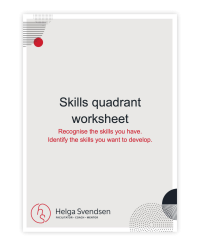As a leadership coach and facilitator, I believe deeply in the power of insight and reflection to catalyse meaningful change. Growth starts with awareness.
To help guide clients on this journey, I am accredited in four terrific evidence-based diagnostic tools. Grounded in research, these tools offer practical, personal insights that spark action. They help leaders understand themselves, how they show up, and how they can grow.
The accredited tools I use with individual coaching clients:
- January 2020: Leadership Development Profile (LDP) – through Harthill Consulting
- October 2021: Life Styles Inventory (LSI) – through Human Synergistics
- January 2023: Emotional Capital Report (ECR) – through Fire Up Coaching (a Roche Martin tool)
- April 2025: Psychological Safety Index (PSI) – through Fire Up Coaching and Data Drives Insight
Some of these have ‘sister’ tools that can be used for groups and organisations, such as:
- LSI for groups: Organisational Culture Index (OCI) or Group Styles Inventory (GSI)
- PSI for groups: Psychological Safety Teams Index (PSTI)
Why I picked these four tools
These tools were either recommended to me or I have witnessed their use and impact in various organisations.
- The Leadership Development Profile (LDP) is used by Leadership Victoria. I undertook the Leadership Victoria’s Williamson Community Leadership Program in 2010. It was a turning point in my career.
- I was introduced to the widely-used Life Styles Inventory (LSI) tools while working for Sustainability Victoria. Although facilitation was a big part of my work as a union official, it was Sustainability Victoria that put the word ‘facilitator’ in my job title. I haven’t looked back…
- The Emotional Capital Report (ECR) and Psychological Safety Index (PSI) tools came recommended by Kathy McKenzie from Fire Up Coaching, an Australian organisation that provides International Coaching Federation (ICF) accredited training.
Picking the right tool for each coaching client
My one-on-one individual coaching program clients fill out their ‘pre-coaching reflection’ before the first session of their eight sessions (over six months). This helps to identify the key challenges and leadership skills they want to work on.
Then, if it suits their goals, we talk through which tools would be right for them.
Here’s a snapshot of the kind of information I share with my coaching clients.
Leadership Development Profile (LDP)
About: The LDP was developed by Harthill Consulting based on work by developmental psychologists such as Jane Loevinger in the 1960s and 1970s. It’s a sentence-completion assessment tool that looks at how individuals interpret experiences and make decisions – a process known as ‘sense-making’. It is widely used to assess and develop leadership capabilities in individuals and organisations.
How it works: Participants are asked to complete 32 open-ended sentences such as ‘a good leader…’ and ‘rules are…’. The responses are then analysed to determine the participant’s developmental stage. These developmental stages – which the LDP calls ‘action logics’ – describe the ways leaders make decisions, plan actions and respond to challenges. Each stage reflects increasing complexity in thinking, self-awareness, and leadership capacity.
How long it takes:
- Sentence completion exercise: 30 to 40 minutes
- Feedback: A 90-minute debrief session
Outcomes:
- Insight into resiliency and decision-making
- Clarity on leadership maturity and development stage
- A personalised Leadership Development Profile report
What this coaching client had to say about using LDP with me:
“I used the LSI and LDP tools in 2021 while getting leadership coaching from Helga and they were transformative.
“I initially found the LDP tool fascinating above all else. The nature of the questions is quite unique and makes you step out of your comfort zone a little. There’s a tendency to try and ‘second guess’ the responses to game the system! But once you let that go and just respond as thoughtful as you can it’s actually a lot of fun. The results – in the form of the 45-page Leadership Development Profile – were clear and it’s easy to understand.
“One of the recommendations to support me along the journey (based on where I sat on the LDP) was to challenge myself to reflect in new ways about the dilemmas in work and life. It was quite specific at times, suggesting to explore the I Ching, Enneagram, or provocations of others. Or read authors like Block, Senge or Hammer. I ended up borrowing and then buying the I Ching. Nearly the years later I still use it daily to bring me back to the character traits I want to be true to.”
Alexi (Lex) Lynch, CEO of Footy for Climate
The Life Styles Inventory (LSI)
About: Human Synergistics founder J Clayton Rafferty created The Life Styles behavioural diagnostic tool in 1973 in collaboration with Robert A Cooke. The LSI combines self-assessment with feedback from colleagues to help individuals understand how they perceive themselves and how they are perceived by others. This leads to a greater understanding of the mindsets and habits that support or hinder leadership effectiveness.
How it works: There are two parts:
- LSI 1 (self-assessment): Individuals assess their own thinking styles, personal effectiveness, and satisfaction at work and home
- LSI 2 (feedback from others): Up to 12 peers, managers, or subordinates provide 360-degree feedback on the individual’s behaviour and effectiveness
Both assessments generate a profile that shows thinking styles across 12 areas, grouped into three clusters:
- Constructive styles: Promote personal growth, teamwork, and adaptability
- Passive/defensive styles: Reflect avoidance and security-seeking behaviours
- Aggressive/defensive styles: Indicate competitive or oppositional tendencies
How long it takes:
- LSI 1: 20–30 minutes
- LSI 2: It depends on number of respondents
- Feedback: 90-minute debrief session
Outcomes:
- Objective understanding of thinking and behaviour patterns
- Feedback to highlight blind spots and strengths
- A roadmap for positive change in the form of a LSI report
What this coaching client had to say about using LSI with me:
“Going through the LSI process was the first time I’ve gone through genuine 360/colleague feedback and the first time in a long time I’ve undertaken a self-assessment process. It certainly puts you slap in the middle of the world of vulnerability. I was always a little reserved about some of these tools and the prospect of being put in a box, but of course it’s nothing like this at all.
“Early in my coaching journey with Helga I was asked to reflect on any recent personal growth and I asked her to elaborate and explain what she meant. The response was to look for periods of change, sitting with uncertainty or feeling uncomfortable. Bingo! LSI put me right in that.
“The results of the assessments were really interesting. I was really happy with the ‘description by others’ scores until I saw the isolated response from my manager, which had a lot more ‘colour’ in the quadrants I didn’t expect to see. This was until Helga pointed out that my self-assessment and that of my manager were almost identical. A world of investigation there, really positive discussions with my team and ways to hone in on the attributes I want to bring to my work and teams.”
Alexi (Lex) Lynch, CEO of Footy for Climate
Emotional Capital Report (ECR)
About: It’s a validated, scientifically developed psychometric assessment tool designed to measure and quantify emotional intelligence (EQ) in relation to leadership potential. EQ is seen as a critical differentiator for high-performing leaders.
How it works: The ECR can be used as a self-assessment tool, in a 360° feedback format or for groups and teams. It measures 10 core emotional intelligence competencies in these three categories:
- Inner: Self-knowing, self-control, self-confidence, self-reliance
- Outer: Adaptability, optimism and self-actualisation
- Other: Empathy, relationship skills, straightforwardness
How long it takes:
- Assessment: 20–30 minutes
- Feedback: 60–90 minute debrief session
Outcomes:
- A Total Emotional Capital score and scores for each competency
- A benchmark of current EQ strengths and areas for development
- Practical strategies to improve self-regulation, resilience and empathy
What this coaching client had to say about using ECR with me:
“I’d always felt I had a very high emotional intelligence (EQ), however, I am cognisant that some of my behavioural traits could (at best) be described as ‘quirky’ and other traits don’t always produce the best outcome in the boardroom.
“It was a revelation as I discovered that you can’t ‘have’ (or not have) emotional intelligence. It’s measured through eight facets, not one – and you’re likely strong in some and weaker in others. It wasn’t black and white. You could measure strongly in some areas and not in others.
“The ECR helped me cement what my superpowers are (self-actualisation and empathy). Things you just think and do and assume everyone does too, but they don’t! It also identified a few areas of ‘development need’ (self-control and adaptability). It was a bit of an ‘ah ha!’ moment. As for how I’m going to develop them, well that’s for the next coaching session.”
Marianna O’Gorman, deputy chair, Australian Renewable Energy Agency
Note: To read the rest of what Marianna had to say about the ECR, we’ve updated the case study about her one-off strategy sessions (scroll to the end).
Psychological Safety Index (PSI)
About: Developed by Data Drives Insight, the PSI is a research-backed diagnostic tool used to measure an individual’s level of psychological safety in the workplace. It provides individuals with feedback from line managers, peers and direct reports on how they’re currently performing against high performance leadership competencies.
How it works: A short, anonymous online survey asks individuals and nominated raters (line managers, peers and direct reports) to rate 51 quantitative statements on a scale (often 1–7, from ‘strongly disagree’ to ‘strongly agree’). The tool then generates a personalised report with a psychological safety score.
The PSI looks at psychological safety across four domains:
- Connecting: Managing team conflict and building cross team relationships
- Caring: Being calm in a crisis and providing respectful feedback
- Curious: Staying open to ideas and balancing questions with opinions
- Purposeful: Aligning work to organisational purpose and personal commitment
How long it takes:
- Online self-assessment survey: 10 minutes
- Online nominated raters survey: 10 minute each
Outcomes:
- Awareness of the individual’s experiences and perceptions of psychological safety at work
- Insights into what might be helping or hindering the individual’s ability to contribute openly
- Feedback to help identify strengths and improvement areas to guide the individual’s development as a leader







